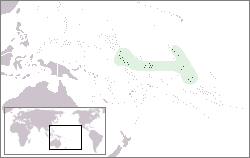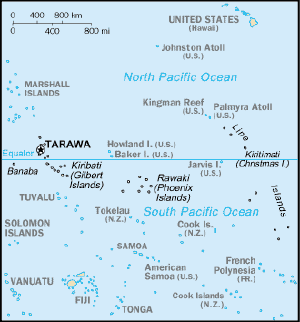Difference between revisions of "Kiribati" - New World Encyclopedia
Mike Butler (talk | contribs) (Kiribati - importing) |
Mike Butler (talk | contribs) m |
||
| Line 147: | Line 147: | ||
[[Category:Oceanian countries]] | [[Category:Oceanian countries]] | ||
[[Category:Pacific Ocean atolls]] | [[Category:Pacific Ocean atolls]] | ||
| + | {{credit|51800257}} | ||
Revision as of 08:00, 12 June 2006
| Republic of Kiribati | ||||||
|---|---|---|---|---|---|---|
|
||||||
| Motto: Te Mauri, Te Raoi ao Te Tabomoa (English: Health, Peace, and Prosperity) |
||||||
| Anthem: Teirake Kaini Kiribati |
||||||
| Capital (and largest city) | South Tarawa 1°28′N 173°2′E | |||||
| Official languages | English and Kiribati | |||||
| Government | Republic | |||||
| - | President | Anote Tong | ||||
| Independence | ||||||
| - | from UK | 12 July 1979 | ||||
| Area | ||||||
| - | Total | 811 km² (170th) 313 sq mi |
||||
| - | Water (%) | 0 | ||||
| Population | ||||||
| - | July 2005 estimate | 99,350 (196th) | ||||
| - | 2001 census | 91,985 | ||||
| GDP (PPP) | 2001 estimate | |||||
| - | Total | $79 million 1 (223rd) | ||||
| - | Per capita | $800 (2001 est.) (222nd) | ||||
| Currency | Australian dollar (AUD) |
|||||
| Time zone | (UTC+12, +13, +14) | |||||
| Internet TLD | .ki | |||||
| Calling code | +686 | |||||
| 1.) Supplemented by a nearly equal amount from external sources. | ||||||
Kiribati, officially the Republic of Kiribati ['kiri:bæs], is an island nation located in the central tropical Pacific Ocean. The country's 33 atolls are scattered over 1,351,000 square miles (3,500,000 km²) near the equator. Its name is pronounced /kiribas/ and is a Kiribati language rendering of "Gilberts", the English name for the main group of islands: the former Gilbert Islands.
History
Kiribati was inhabited by a single Micronesian ethnic group that spoke the same Oceanic language for 2,000 years before coming into contact with Europeans. The islands were named the Gilbert Islands in 1820 by a Russian admiral, Adam von Krusenstern, and French captain Louis Duperrey, after a British captain, Thomas Gilbert, who crossed the archipelago in 1788 ('Kiribati' is the islanders' pronunciation of plural 'Gilberts').
In 1892, the Gilbert Islands became a British protectorate together with the nearby Ellice Islands. They became a colony in 1916 and finally became autonomous in 1971. In 1943, the Battle of Tarawa was fought at Kiribati's capital Bairiki on Tarawa atoll.
In 1978, the Ellice Islands became the independent nation of Tuvalu, and Kiribati's independence followed on July 12, 1979. With independence, the United States relinquished all claims to the sparsely inhabited Phoenix Islands and all but three of the Line Islands, which became part of Kiribati territory.
Politics
Politics of Kiribati takes place in a framework of a presidential representative democratic republic, whereby the President of Kiribati is the head of government, and of a pluriform multi-party system. Executive power is exercised by the government. Legislative power is vested in both the government and the House of Assembly. The Judiciary is independent of the executive and the legislature.
Districts and local councils
There are no more districts, but a group that unites the Line and the Phoenix islands (ministry at London, Christmas). Each inhabited island has its own council (3 councils on Tarawa: Betio, South-Tarawa, North-Tarawa; 2 councils on Tabiteuea). Kiribati was divided into 6 districts until independence:
- Banaba
- Central Gilberts
- Line Islands
- Northern Gilberts
- Southern Gilberts
- Tarawa
Four of the former districts (including Tarawa) lie in the Gilbert Islands, where most of the country's population lives. Only three of the Line Islands are inhabited, while the Phoenix Islands are uninhabited except for Kanton and Orona (80 people) and have no representation. Banaba itself is sparsely inhabited now. There is also a non-elected representative of the Banabans on Rabi Island in the nation of Fiji.
Each of the 21 inhabited islands has a local council that takes care of the daily affairs. Tarawa atoll has three councils: Betio Town Council, Te Inainano Urban Council (for the rest of South Tarawa) and Eutan Tarawa Council (for North Tarawa).
Geography
Kiribati consists of about 32 atolls and one island (Banaba), with at least three in each hemisphere. The groups of islands are:
- Banaba: an isolated island between Nauru and the Gilbert Islands.
- Gilbert Islands: 16 atolls located some 930 miles (1,500 km) north of Fiji
- Phoenix Islands: 8 atolls and coral islands located some 1,100 miles (1,800 km) southeast of the Gilberts
- Line Islands: 8 atolls and one reef, located about 2,050 miles (3,300 km) east of the Gilberts.
Banaba (or Ocean Island) is a raised-coral island that was once a rich source of phosphates, but it was mostly mined out before independence. The rest of the land in Kiribati consists of the sand and reef rock islets of atolls or coral islands that rise but a few meters (at most 6.5 feet) above sea level. The soil is thin and calcareous, making agriculture very difficult.
Kiritimati (Christmas Island) in the Line Islands is the world's largest atoll.
Based on a 1995 realignment of the International Date Line, Kiribati is now the easternmost country in the world, and was the first country to enter into the year 2000 at Caroline Island, which, not coincidentally, has been renamed Millennium Island. ([1])
Two uninhabited Kiribati small islets, Tebua Tarawa and Abanuea, disappeared underwater in 1999, according to the South Pacific Regional Environment Program, and the islet of Tepuka Savilivili (Tuvalu) (not a Gilbertese name!) no longer has any coconut trees due to salination.[2] The United Nations Intergovernmental Panel on Climate Change predicts that sea levels will rise by about half a meter (20 in) by 2100 due to global warming, with further rise inevitable. It is thus only a matter of time before the arable land becomes subject to increased soil salination and the nation is largely submerged. [3]
Economy
Kiribati has few natural resources. Commercially viable phosphate deposits were exhausted at the time of independence. Copra and fish now represent the bulk of production and exports.
Tourism provides more than one-fifth of GDP. Foreign financial aid, largely from the United Kingdom and Japan, is a critical supplement to GDP, equal to 25%-50% of GDP in recent years.
Demographics
The name of the people is Gilbertese (or I-Kiribati, in Gilbertese). While English is the constitution's and law's language, Kiribati, the native Micronesian language, is widely spoken. Note that in Gilbertese there is no letter 's', the sound is represented by 'ti'. That is why Kiritimati Island is known in English as Christmas Island (not to be confused with the Christmas Island in the Indian Ocean, which is administered by Australia). Christianity is the major religion in the country, although mixed with many practices of the indigenous beliefs.
Culture
There is a great importance of the songs (te anene) and above all of the dances (te mwaie).
- Music of Kiribati
- Dance of Kiribati: see Robert Louis Stevenson's In the South Seas and the Montana New Zealand Book Awards winner Akekeia! by Tony & Joan Whincup, Wellington, 2001.
Miscellaneous topics
- Communications in Kiribati
- Foreign relations of Kiribati
- Military of Kiribati
- Transportation in Kiribati
- Kiribati Scout Association
External links
Template:Pacific Islands
Credits
New World Encyclopedia writers and editors rewrote and completed the Wikipedia article in accordance with New World Encyclopedia standards. This article abides by terms of the Creative Commons CC-by-sa 3.0 License (CC-by-sa), which may be used and disseminated with proper attribution. Credit is due under the terms of this license that can reference both the New World Encyclopedia contributors and the selfless volunteer contributors of the Wikimedia Foundation. To cite this article click here for a list of acceptable citing formats.The history of earlier contributions by wikipedians is accessible to researchers here:
The history of this article since it was imported to New World Encyclopedia:
Note: Some restrictions may apply to use of individual images which are separately licensed.




